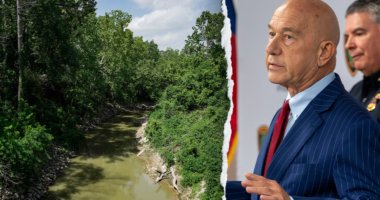Share this @internewscast.com
AN ANCIENT pyramid thought to be a ‘gateway to underworld’ was discovered to contain a hidden secret.
The historic site, located in an ancient city, is thought to house a supernatural secret.
Quetzalcoatl Temple in Mexico, also known as the Feathered Serpent Pyramid is thought to have been built around 1,800 to 1,900 years ago.
During an excavation project researchers discovered large amounts of liquid mercury in 2015.
Its something experts believe means the structure was used to ‘look into the supernatural world.’
They also believe its presence could indicate that a king’s tomb or ritual chamber could be lying underneath the ancient city of Teotihuacan.
The pyramid was originally unsealed in 2003, allowing researchers like Dr Sergio Gómez to spend six years excavating the tunnel.
During this excavation, researchers uncovered three chambers at the end of a 300 foot tunnel.
In addition to the liquid mercury, they also found artefacts like jade status, jaguar remains, and a box of carved shells and rubber balls.
The tunnels and adjoining structures lie 60 feet below the temple.
In their 16 years excavating the temple, the research team uncovered over 3,000 ceremonial and ritual artefacts.
They have used their discoveries to create a comprehensive survey of the pyramid and tunnel using LiDAR scanners and photogrammetry.
Liquid mercury isn’t an unusual finding, as archaeologist Dr. Rosemary Joyce points out that the substance has been uncovered at three different sites in Central America.
Its believed that mercury symbolises an underworld river or lake.
Dr. Annabeth Headrick concurs with this view, informing the Guardian that the properties of liquid mercury could symbolize “an underworld river, akin to the river Styx.”
“Mirrors were considered a way to look into the supernatural world, they were a way to divine what might happen in the future.
“It could be a sort of river, albeit a pretty spectacular one,” Dr Headrick added.
The Quetzalcoatl Temple is located around 12 miles northeast of Mexico City in Teotihuacán – the heart of the Mesoamerican Teotihuacan universe.
Around 4.5 million people visit the temple – which is the third largest in the city – every year.
In 1987, it was designated a UNESCO World Heritage Site, and by 2004, it was placed on the World Monuments Watch due to its deterioration from increased tourist visits.
More than a hundred human remains, which may have been sacrificial victims, were found under the structure in the 1980s.
The Aztecs believed it was the place where Gods were created, with sacrifices being made as tributes.























